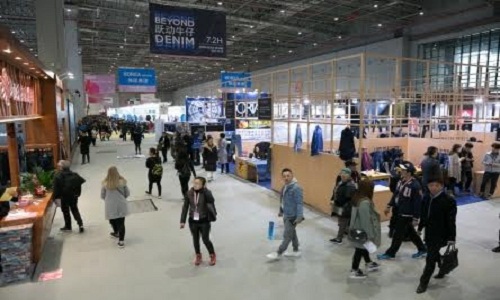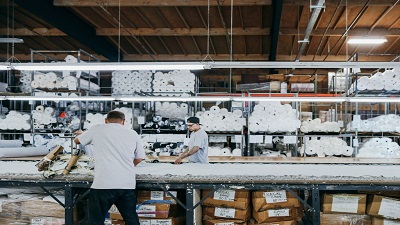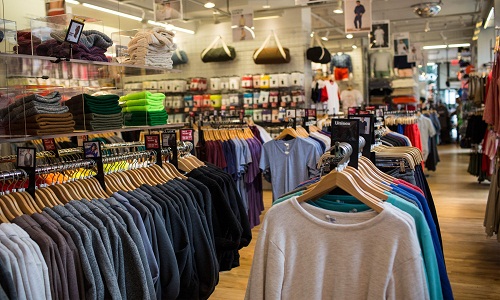FW
Nandan Denim manufactures of superior grey cotton fabrics, khakis and denim plans to increase production capacity to 110 million meters per annum by the next quarter and become the country's largest denim producer. At present, it has a denim production capacity of 71 million meters per annum.
Out of a total capital outlay of Rs 612 crores for expansion, Nandan has already spent Rs 400 crores and the remaining Rs 212 crores will be spent in the next four or five months. The expansion program was funded through a debt of Rs 430 crores and internal accruals of Rs 180 crores. Besides denim, capacity, the company is also expanding its spinning and shirting segments. The company is increasing spinning capacity from 54 tons per day to 124 tons a day and yarn dyeing shirting capacity to 10 million meters.
The company exports denim fabric to over 28 countries. Exports will contribute about 30 per cent of the overall business in two years. Nandan Denim commenced operations in 1994 with the textile trading business and forayed into textile manufacturing in 2004. The company hopes to register a turnover of around Rs 1,400 crores in the financial year 2016-17.
www.nandandenim.com/
Proposed changes to Australia's wool selling system have been met with resistance from wool buyers and exporters. It is being discussed as government-and-grower-funded body Australian Wool Innovation (AWI) embarks on a restructure. Long-term AWI staff, including Jimmy Jackson and Rob Langtry, will leave the corporation in the middle of the year.
Review of the wool selling system began by AWI more than a year ago and considered dozens of submissions from wool growers and buyers. It says the aim is to modernise the system and reduce costs to wool growers, while also increasing transparency. AWI is consulting industry about the changes, and said it would bring together a panel of experts by May to drive the digital transformation. Further, a business case will be delivered to the AWI board by November 2016.
According to a wool buyer, Chris Kelly, from the National Council of Wool Selling Brokers said more than 90 per cent of buyers were against change. He said the current open-cry auction was already modern and based on pre-sale wool testing. Wool buyers and growers are also raising concerns about the loss of highly experienced wool industry stalwarts at AWI.
The recently concluded, first 2016 TEPP promotional campaign at ISPO MUNICH was a huge success and the next Taiwan Select will be held at SaigonTex from March 30 to April 2 at the Saigon Exhibition & Convention Center (SECC), in Ho Chi Minh City, Vietnam. On display will be all kinds of textiles sample, including eco-textile, functional and fashion textiles, dyes, and trimmings from Taiwan exhibitors.
The TITAS 2015 saw 15 firms representing ‘Taiwan Textile Associations’. Each one is an integral, planned and coordinated part of the federation. TITAS is a leading trade show for innovation, function and fashion fabrics. The aim is to make textile shopping simplified and focused. Moreover, a program called TEPP (Taiwan Export Promotion Program) started as a four year marketing concept and is now in its 7th year. It brings unique Taiwan textiles and a broad collection of Taiwanese companies to the market. TEPP brings together diverse customers and suppliers together and augments the progress of many facets in the innovative, sustainable textile endeavors that make Taiwan the right place to be. Each year, TEPP grows in value and product diversity.
A subtle part of the value of Taiwan textile industry is its ease of access and communication, and the TTF will help make a business trip as efficient as possible.
The 2nd Global Geosynthetics Summit will be held May 19 to 20, 2016 in New Delhi, India. The summit will highlight the strong focus on infrastructure, which include roads and bridges, railways, and coastal and river protection. Through this program, it will address India’s ambitious infrastructure initiatives, related standards, gaps needing to be filled in regulation, and opportunities for geosynthetics.
The goals of the summit are: take stock of existing guidelines, code provisions, and accreditation processes for adopting geosynthetics in the event’s infrastructure sectors of focus; gather key stakeholders to deliberate on mechanisms for encouraging geosynthetics as an innovative solution; identify the hurdles faced by agencies in adopting geosynthetics solutions and how their concerns can be addressed; review available product specifications, design guidelines, existing publications and the extent of their implementation; discuss how available resources or new guidelines could mandate the implementation of geosynthetics in infrastructure; adapt international guidelines to Indian conditions; develop a larger accredited geosynthetics testing laboratory network in India; encourage life-cycle cost analysis method for evaluating the real economic cost of the project; assess carbon foot print of infrastructure projects; make use of geosynthetics mandatory for all road and railway projects to the extent of a minimum percentage of the total project costs among others.
The previous iteration of the summit was held in September 2014 with the theme ‘Enhancing the Application of Geosynthetics in Infrastructure.’
‘Denim - Democracy in Fashion,’ a conference organized by Diagonal Consulting India recently in Ahmedabad recently saw an in-depth presentation of the global denim market and trends by J Berrye Worsham, President & CEO, Cotton Inc. At the conference, denim stalwarts were in agreement that the market has never been as good as the present time. Fashion weeks across the world are highlighting denim as an important trend. In India, denim industry is on a growth trajectory, with many of the major players increasing capacities. Demand for denim apparel is growing the fastest among all apparel segments in the country, with denim fabric makers finding it difficult to keep pace with the demand.
Speaking on the occasion, P R Roy, Chairman, Diagonal Consulting in India said India has witnessed unbridled growth in denim production in the last couple of years. Today, India produces 1.2 billion meters of fabric, this could soon touch 1.5 billion meters. Sharing his experience, S N Modani, Managing Director, Sangam, said his company will reach a production capacity of 60 million metres by the end of 2016, with a strong focus on exports. In a discussion Worsham and Aamir Akhtar, CEO, Lifestyle Fabrics- Denim, Arvind Mills talked about the challenges that the industry faces in terms of consumer preferences: athleisure over denims, sizing and fit concerns in an aging US population, concerns over stretch recovery, the increasing use of manmade fibres in denim, and more. Worsham said the India’s domestic market could well amend any recessionary trend for producers, however, Akhtar, said while the market is growing fast, as it matures, growth will slow down. Moreover, the market is not totally insulated with factors like cotton, forex volatility etc at place. These do not keep a denim manufacturer in the comfort zone for long. The preference away from denim is visible, though to a lesser extent, in the Indian market. Eventually, manufacturers will need to look at innovations and varieties to attract consumers.
"The latest edition of Intertextile Shanghai Apparel Fabrics-Spring Edition took place against the backdrop of uncertainty in global textile markets – indeed, the economy was on everyone’s mind. And while some in the industry are feeling the impact of China’s slowdown, many international exhibitors at the fair reported little or no impact from the economic situation."

The latest edition of Intertextile Shanghai Apparel Fabrics-Spring Edition took place against the backdrop of uncertainty in global textile markets – indeed, the economy was on everyone’s mind. And while some in the industry are feeling the impact of China’s slowdown, many international exhibitors at the fair reported little or no impact from the economic situation.
Wendy Wen, Senior General Manager, Messe Frankfurt (HK) explained on Wendy Wen, Senior General Manager, Messe Frankfurt (HK) explainedthe final show day said they expected sentiment to be down somewhat this year but were pleasantly surprised by the relative optimism from exhibitors and buyers. “It is reasonable to say the industry in China is going through a period of change but it is far from in decline, with the development and growth of this fair over the last year a strong indicator of this. We need to keep things in perspective as well: with overall growth remaining above 6 per cent for the foreseeable future, this will still present many opportunities for overseas suppliers in China,” she said.
Optimistic buyers and exhibitors

As further proof that the industry is more resilient than assumed, particularly in China, the visitor figure raised once again, the third consecutive increase since the Spring edition’s move to Shanghai in 2014. The new record set was over 71,000 buyers (which includes buyers from the concurrent Yarn Expo, CHIC and PH Value fairs who also entered the Intertextile Shanghai halls), around 13 per cent increase compared to 2015 (62,649). Wen said they were not expecting such strong growth in buyer figures this year given the macroeconomic climate. However, more than 500 extra exhibitors (3,155 from 27 countries and regions) would have played a part in the increase.
Confident about the future
At the show across various product categories, exhibitors in the International Hall were cautious yet positive about the Chinese and global textile industry in the coming year. Explaining that their regular buyers had already placed orders and they had received many new enquiries as well, Jose Maria Loren from Spain’s Luca Cuccolini, an accessories supplier, commented that the economy will not affect the industry much. This exhibition is good to attract buyers not just from China, but also Asia, so it helps us to sell our products throughout the region, he opined.
French company, Malhia Kent was also optimistic about the future. “The high end of the market will always be resilient here; it’s slowed down recently but it’s not getting worse,” said Aris Arakelian, Commercial Manager. “We received one big order and a few others on the first day of the fair, and our turnover in China has been very good,” he added.
Buyers reiterated the sentiment of exhibitors. As Yuan Hui, a sourcing representative for Chinese apparel brand 15 Hours opined, mid to high range apparel market is the core of their business and is largely unaffected by the economy. Hui also appreciated the organisation of the exhibitors in country and product groupings that allowed him to easily source his target fabrics. “The fair gives me a comprehensive range of products for selection, so despite the size, I can find exactly what I’m looking for,” added Hui.
Intertextile Shanghai Apparel Fabrics-Spring Edition 2016 was held at Shanghai, China during March 16 to 18, 2016 and was co-organised by Messe Frankfurt (HK) Ltd; the Sub-Council of Textile Industry, CCPIT; and the China Textile Information Centre.
While there are plenty of challenges with making products in the US, finding solutions to these hard problems is what seems to make these companies tick. These new manufacturers believe that jobs in Shenzhen (China) are just as important to the families in Shenzhen as they are to American families. For them, there is something cool about the fact that American-made clothing companies are disproving what they have been told for the last 40 years about how American manufacturing is dead.

There are plenty of challenges with making products in the US, finding solutions to these hard problems is what seems to make these companies tick. Three year old Yogasmoga started by Rishi Bali, Founder and CEO manufactures om-inducing clothes 60 miles south of Boston in the gritty town of Fall River, Massachusetts. In the 19th century, Fall River was an important textile hub in New England, second in the world only to Manchester, England, in terms of textile production. Over the last few decades, majority of factories in these parts have shut down as manufacturing has moved offshore to places such as China and Vietnam, where labour is cheaper.

However, Bali wanted to create his own technical fabrics, monitor quality, and have the flexibility to scale up his business as quickly as possible. He believes the only way he was able to accomplish these goals was to set up production in the US. And this decision is paying off: Last year, the company had a valuation of $74 million and opened its 12th store. By using local factories, Bali is able to meet demand much quicker.
Bali is part of a nascent trend of clothing startups bringing business back to American factories. Over the past two decades, there was a 90 per cent decline in apparel manufacturing industry in the US, from 940,000 jobs in 1990 to 136,000 in 2015. This has been in part due to the Trans-Pacific Partnerships, which provide incentives such as lower tariffs for companies that want to produce clothes overseas - though the merits of free trade have been hotly contested in this election cycle.
Manufacturing to remain stable
Now after a mass exodus of manufacturing jobs overseas, in 2012 local manufacturing began to stabilise, believes Bob Bland, Founder and CEO of Manufacture New York, an organization that helps fashion startups create their products in New York City. Part of this shift can be attributed to clothing startups that have started moving back into American factories instead of instinctively going overseas. Bland also believes that these numbers underestimate how much work is being done in the US because many fashion designers and artisans are not being counted by Bureau of Labor Statistics.
For fledgling companies, there are some benefits to work locally. While clothes cost less per unit, one needs significant capital to even begin production. This is what Sasha Koehn and Erik Schnakenberg discovered when they decided to launch the Los Angeles-based menswear label Buck Mason in 2014. Their goal was to produce American-made basics: simple T-shirts, jeans, and button-downs. They together put in $5,000 each and found a local factory in LA to make the tees. That entire budget would have been eaten up on our plane ticket to China. By selling initial products online, they were able to start making others. By year two, they were pulling in several million dollars in sales and opening their first physical store.
Kate Bowen and Ashley Wayman, who launched children's wear brand Petit Peony a year and a half ago, have a similar experience. They explored local factories to see what the minimum order was to start production. They ended up at Griffin, the same factory that Yogasmoga uses, where they only needed to purchase 1,000 units in each print and size to secure a contract.
Can startups grow to mainstream?
While small startups are finding some immediate benefits to creating products in local factories, manufacturing in the US can only begin to compete with overseas in terms of quality, speed to market, and even cost, when they are able to scale up. One good example of this is American Giant, a four-year old company founded by Bayard Winthrop, known for creating durable American-made sweatshirts that have garnered a cult following. Winthrop has observed that while manufacturing abroad drives down labour costs, it also requires companies to mark up their products because a significant chunk of their inventory will never get sold - some products will be discarded because of poor quality, slow turnaround time means that some clothes will no longer be fashionable when they reach stores, and designers often make bad bets on color schemes or patterns and aren't able to withdraw orders.
American-made products will never be as cheap as the $3 T-shirts sold at H&M or Primark. American Giant sweatshirts cost around $90, which places them on par with those at Banana Republic or J Crew. However, CEOs who make products locally argue that customers are getting much better value.
But not all startups are able to grow as quickly as American Giant and Yogasmoga, and take advantage of the economic efficiencies that occur at such a large scale. Companies committed to manufacturing locally are innovating at the level of fabric and design, but they also have to be creative in terms of the entire supply chain.
While there are plenty of challenges with making products in the US, finding solutions to these hard problems is what seems to make these companies tick. These new manufacturers believe that jobs in Shenzhen (China) are just as important to the families in Shenzhen as they are to American families. For them, there is something cool about the fact that American-made clothing companies are disproving what they have been told for the last 40 years about how American manufacturing is dead.
Le Tien Truong, General Director of the Vietnam Textile and Garment Group (Vinatex) feels, participating in the Trans-Pacific Partnership (TPP), Vietnam's garment industry will have a competitive advantage. Speaking at a seminar on Vietnam’s garment industry in Ho Chi Minh City recently he said, Vietnam maintained growth of over 10 per cent only during 2007-2014 when Vietnam had no new trade agreements and many countries saw the fall of exports of garment-textile products (entirely based on its competitiveness). In terms of technical productivity, the Vietnamese garment industry reached the world’s top three.
In 2015, Vietnam exported $27.5 billion of garment-textile products but it had to spend $14 billion to import raw materials. Of the remaining $13.5 billion in the country, we spent $6 billion to pay salaries and over $ 7 billion for domestic raw materials. Going forward, Vietnam needs to overcome the problem of input raw materials, said Truong. Vinatex CEO added that in Vietnam, businesses only need $3,000 to invest in a position of garment worker (people and technology) but up to $200,000 for a fiber or dye worker.
Truong said that it is extremely hard for small and medium enterprises to invest in the textile and dyeing industry. So, Vietnam needs up to $15 billion to invest in the industry, he concluded.
Tunisia is among the top 15 garment suppliers in the world, and has the advantage of being close to the European market. It is the fifth largest supplier to the European Union as well as the leading trouser supplier to the EU. Other important products are work wear and lingerie. The main foreign investors in the apparel sector in Tunisia are France, Germany, Belgium and Italy. Now the trade association of garment and clothing manufacturers within Tunisia's employers' organization, CONECT has signed an agreement with trade show organiser Messe Frankfurt, to promote its industrial products internationally.
Messe Frankfurt pledged to promote Tunisian textile and apparel companies with a dedicated pavilion at the Apparel Sourcing trade show in Paris next September and February. The organiser will also be involved in implementing specific promotions in northern Europe and Germany. This agreement is a result of falling European imports of textiles and apparels sourced from Tunisia. With nearly 96 per cent of Tunisia’s apparels destined for EU, in a few years, the country fell from 4th to 9th position in the ranking of apparel suppliers. The country has over 30 centers for specialised education covering the textile industry, sectoral centers for training supervisors and technicians, a higher institute of textiles for senior technicians, a textile engineering university and a higher institute for fashion professionals.
Clothing and textile exports represent 36 per cent of total Tunisian exports. The clothing sector alone represents 91 per cent of textile and clothing exports: 72 per cent for woven garments and 19 per cent for knitted goods.
However Tunisia’s textile and clothing industry needs to diversify its products and move beyond its current markets and look instead at export opportunities in, eastern Europe, the Middle East, Scandinavia and sub-Saharan Africa
New treatments and technologies have made cotton suitable for the outdoors market. More and more outdoor retailers and brands are realizing cotton can perform as well as or better than synthetics.
Cotton is an incredibly absorbent fiber. Fabric engineering and textile chemistry have been able to adapt the way cotton addresses both exterior and interior moisture management and thermal regulation. Consumers now prefer active wear made from natural fibers such as cotton or cotton blends or wool. They choose cotton active wear over synthetics if the cotton apparel had thermal regulating properties, dried faster, wicked moisture and did not show sweat.
‘Storm Cotton’ technology is a finish that provides water resistance to cotton fabrics. Wicking Windows transfers moisture away from the skin to the outside of a garment, keeping its wearer drier and more comfortable during exercise. A single-knit jacquard is inspired by the underside of a mushroom. It consists of a flat, tightly knit outer surface and an insulating interior with peaks and valleys. The tight construction of the outer layer helps protect the wearer from wind. The multiple folds and grooves increase the surface area of the fabric, helping the wearer to retain body heat.












